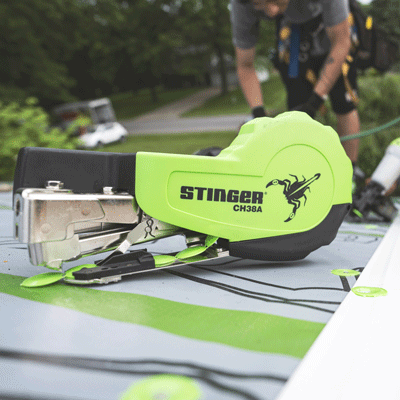
Staple Showdown: A-11 Staples vs. Cap Staples
Fast and inexpensive, staples used to be the go-to fastener for installing housewrap. Now, there's a new best practice fastener—cap staples.

It goes without saying that when installing a moisture barrier on a home, you want to use materials that will keep moisture out. But many installers still use simple A-11 staples to secure housewrap, which, while fast to install, have a higher chance of leading to issues down the road.
So what's the better alternative? Cap staples are now the best practice fastener that housewrap manufacturers often require. Let's break down the differences between these fasteners so you can see why caps are the best option.
Fastener Quality and Performance
A regular A-11 staple doesn't stand a chance of keeping housewrap secure in strong wind gusts. The result is a damaged housewrap that is blown off and will need to be replaced, which wastes both time and resources. On the other hand, housewrap installed with cap staples requires fewer fasteners and will stay in place, even in high winds, thanks to the greater surface area surrounding the fastener. We even put STINGER® cap staples to the test, and they hold on in 150mph winds for 60 minutes, limiting tear-aways in some of the harshest conditions.
Staples also have a hard time keeping the rain at bay as the water can penetrate the fastener holes, defeating the purpose of installing housewrap in the first place. Alternatively, caps create an effective seal around the staple, reducing moisture penetration at the fastener holes. So whether it's wind, rain, or both, cap staples can weather the storm.

Speed of Installation
While it is fast to tack up housewrap with a hammer tacker and A-11 staples, you'll likely spend more time re-installing the housewrap that's torn and blown away. You don't have to sacrifice the speed of installation for quality of work, which is essential when protecting a home against moisture. Instead, use a cap hammer or pneumatic cap stapler for a fast installation with cap staples. For those who like using a hammer tacker and 3/8" crown staples, pick up the STINGER CH38-2 cap hammer, which functions similarly but features a trigger to feed a cap through. There is also the STINGER CH38A that advances the next cap with every strike. Both tools are compatible with 3/8" StaplePac®, which includes 12 rolls of 168 collated plastic caps and 24 strips of 84 staples.
For more power, precision, and speed, use the CS150B cap stapler. This tool has a bumpfire and a sequential mode, so you can load up your tool and fly through the installation. In addition, the CS150B holds 200 caps and staples for reloads that happen infrequently and simultaneously. This versatile tool is also the best option if you want to use a variety of 18 gauge 7/16" crown staple lengths as it adjusts to 5/8", 7/8", 1-1/4", and 1-1/2".
Price Points
They don't perform as well fastening housewrap, but they are fast (upon initial installation) and cheap. For example, a 5,000-count box of A-11 staples costs less than $10, and a hammer tacker is about $30. After that, however, you'll spend what you're saving on tool and fastener costs re-installing the housewrap that's likely blown off.
Producing high-quality work will take a little more investment, but the result is a better-protected home and a better reputation for your crew. The STINGER cap hammer system costs around $60 for a 2,016-count box of 3/8" StaplePac and $60 for the CH38-2 or about $80 for the CH38A. Upgrading to the pneumatic CS150B cap stapler will cost around $250, with the StaplePac's costing about $60-70, depending on the fastener length.
If price is the most significant barrier to entry, remember that using a cap stapling system will save you the most time in the long run so that you can complete even more jobs. STINGER also offers a tool repair service to keep these tools running like new for their lifetime. Most importantly, installing cap staples will help you build better, make homes safer, and protect the homeowner's investment from future moisture problems.